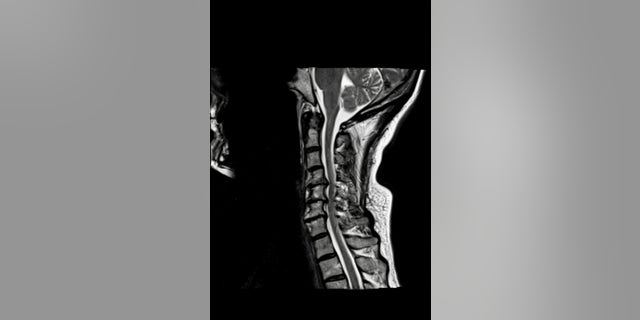Paraplegic Man Walks Again With Bionic Legs
NEWY'all can now heed to Fox News articles!
New enquiry and applied science advise hope for those suffering from paralysis.
Researchers quickly restored motor role in three men with complete paralysis using an epidural electrical stimulation system, according to a new study published in Nature Medicine.
"Thanks to this applied science, we take been able to target individuals with the most serious spinal cord injury, significant those with clinically complete spinal cord injury, with no awareness and no motion in the legs," said lead author Dr. Grégoire Courtine, professor of neuroscience and neurotechnology at the Swiss Federal Constitute of Technology, University Hospital Lausanne and the University of Lausanne.
Even though there is no connection between the encephalon and the extremities later on spinal cord injuries, past research has discovered that some patients with even a "consummate" injury may have some connections that all the same function, according to Medscape.
Although contempo 2022 studies using stimulators to treat chronic hurting in spinal cord patients accept shown promise, the technology is too narrow in scope to target all regions of the spinal cord involving the control of leg and torso movements, the study added.

A cross-section of a 3-D printed adult human femur (image courtesy Northwestern University)
Ordinarily in patients without spinal cord injury, nerves in the spinal cord use signals to communicate with the brain to move the legs, but after a spinal cord injury, the nerve signals are too weak to create movement, co-ordinate to a BBC report.
CDC PROPOSES NEW OPIOID GUIDELINES FOCUSING ON ALTERNATIVES TO TREATING PAIN
The report noted the report inserted a paddle-shaped device that is embedded with electrodes to heave the nervus signals to allow a patient to walk, with wires from these electrodes likewise continued to a neurostimulator that is implanted underneath the skin in the abdomen, according to the newspaper.
Three men participated in the written report, ranging from ages 29 to 41, who all suffered a spinal cord injury due to motorcycle collisions several years prior to inbound the study and so that the researchers knew their injuries were stabilized, according to Medscape.
The news outlet also noted the participants then used a tablet that communicated with the implanted device to select which action they wanted to perform, such as walking or continuing.
But Dr. Peter J. Grahn, assistant professor, Department of Physical Medicine and Rehabilitation and Section of Neurologic Surgery, Mayo Dispensary who authored ane of the 2022 studies on hurting using stimulators, told Medscape although this written report's technology "is a huge step forward," he questioned the written report's definition of walking.

The writer's cervical spine before surgery showing spinal string compression in three areas. ( )
"They say independent stepping or walking is restored on day one, but the graphs prove solar day one function is having over lx% of their torso weight supported when they're taking these steps," Grahn said.
All three men were able to take up to 300 independent steps, but with body support, inside days of starting the spinal stimulation, according to the paper.
One of the participants, Michel Roccati, who was paralyzed after a motorbike accident without any feeling in his legs, said, "I stand up upwardly, walk where I want to, I tin can walk the stairs - it'south almost a normal life."

Professional senior physiotherapist doing manual treatment to a men'due south thoracic spine.
After receiving the spinal implant in August 2020, he could walk with torso back up within one day of the stimulation, which was eleven days after the procedure, co-ordinate to STAT.
"I see the comeback every solar day," he added.
Eellan Sivanesan, manager of neuromodulation in the Partitioning of Pain Medicine at Johns Hopkins School of Medicine, told STAT because information technology's a more invasive process to implant the paddle devise than the typical spinal cord stimulation device, which require surgeons to implant only through a needle, it may "limit the number of physicians readily able to employ the treatment."
DOCTORS PERFORMING CT Browse ON Human being WITH BACK Hurting Discover HE HAS three KIDNEYS: CASE Report
Also, considering at least six cm of healthy spinal string nether the lesion of injury is necessary to implant the electrodes, not all paralyzed patients are eligible for the procedure, according to Medscape.
"There'south a huge variability of spinal cord anatomy betwixt individuals. That's why it's important to study each person individually and to have private models in social club to be precise," said co-author and neurosurgeon Dr. Joceylyne Bloch, associate professor, University of Lausanne and University Hospital Lausanne.
Courtine as well cautions the study's engineering is not a cure for patients with spinal cord injury considering that will require regeneration of the spinal cord, which current stem cell inquiry is trying to accost, but is but in the early stages, according to the BBC.
Go THE Trick NEWS APP Here
"This is not a cure for spinal cord injury. But information technology is a disquisitional stride to improve people's quality of life. We are going to empower people. We are going to requite them the ability to stand, to take some steps. It is non enough, just it is a pregnant improvement," Courtine said.
Source: https://www.foxnews.com/health/paralyzed-men-walk-spinal-cord-implant
0 Response to "Paraplegic Man Walks Again With Bionic Legs"
Post a Comment